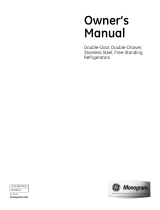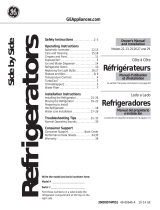Consumer SupportTroubleshooting TipsOperating InstructionsSafety Instructions Installation Instructions
11
Icemaker
Feeler Arm
Power
Switch
Green
Power Light
Feeler Arm in
the STOP
(up) position
Feeler Arm in
the ON (down)
position
Feeler arm model
Power switch model
There are 2 types of icemakers:
About the automatic icemaker.
www.GEAppliances.com
A newly-installed refrigerator may take 12–24 hours to begin making ice.
Automatic Icemaker (on some models)
The icemaker will produce approximately
3 to 3
1
⁄
2 lbs. of ice in a 24-hour period,
depending on the freezer compartment
temperature, room temperature, number
of door openings and other use conditions.
There are two types of icemakers: power
switch models and feeler arm models.
If the refrigerator is operated before the
water connection is made to the icemaker,
set the power switch to O (off) or move the
feeler arm to the STOP (up) position.
When the refrigerator has been connected
to the water supply, set the power switch to
the I (on) position or move the feeler arm to
the ON (down) position. On power switch
models, the green light will come on.
The icemaker will fill with water when it
cools to 15°F. A newly-installed refrigerator
may take 12 to 24 hours to begin making
ice cubes.
Once the icemaker starts to make ice,
it may take up to 48 hours to fill the bin,
depending on the temperature settings
and number of door openings.
You will hear a buzzing sound each time
the icemaker fills with water.
Throw away the first few batches of ice
to allow the water line to clear.
Be sure nothing interferes with the sweep
of the feeler arm.
When the bin fills to the level of the feeler
arm, the icemaker will stop producing ice.
It is normal for several cubes to be joined
together.
If ice is not used frequently, old ice cubes
will become cloudy, taste stale, shrink or
fuse together.
On power switch models, the green power
light will blink if ice cubes get stuck in the
icemaker. To correct this, set the power
switch to O (off) and remove the cubes.
Set the power switch to I (on) to restart the
icemaker. After the icemaker has been
turned on again, there will be a delay of
about 45 minutes before the icemaker
resumes operation.
NOTE: In homes with lower-than-average water
pressure, you may hear the icemaker cycle multiple
times when making one batch of ice.
Icemaker Accessory Kit
If your refrigerator did not already come
equipped with an automatic icemaker,
an icemaker accessory kit is available at
extra cost.
Check the back of the refrigerator for the
specific icemaker kit needed for your model.
To Use the Dispenser (on some models)
The water dispenser is located on the left
wall inside the refrigerator compartment.
To dispense water:
Hold the glass against the recess.
Push the water dispenser button.
Hold the glass underneath the
dispenser for 2–3 seconds after
releasing the dispenser button.
Water may continue to dispense
after the button is released.
If no water is dispensed when the refrigerator is first
installed, there may be air in the water line system.
Press the dispenser button for at least 2 minutes to
remove trapped air from the water line and to fill the
water system. During this process, the dispenser
noise may be loud as the air is purged from the
water line system. To flush out impurities in the
water line, throw away the first 6 glassfuls of water.
NOTE: To avoid water deposits, the dispenser
should be cleaned periodically by wiping with a
clean cloth or sponge.






















